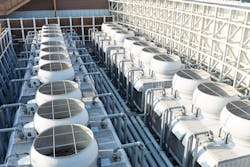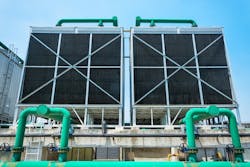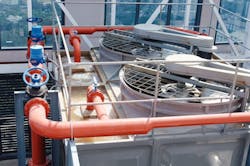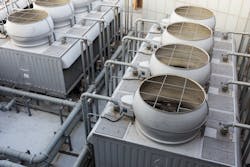About the author:
Obaidullah Mohiuddin, PhD, is an Environmental Scientist for Eneref Institute. Mohiuddin can be reached at [email protected] or 917.779.8600.
The world has not yet woken up to the coming water crisis, as water scarcity will lead to conflicts across the globe, according to a 2018 United Nations report on climate change. In many regions across the world, including California, groundwater is severely depleted because of climate change and other factors, according to NASA. In Asia, 40% of the population depends on only 10 rivers.
“Because of the amount of water used in cooling towers, knowledge facility managers can play a significant role in protecting water supplies and the water ecosystem,” said Seth Warren Rose, founding director of the Eneref Institute. “Technologies that can effectively reduce chemical use in water towers should be implemented wherever practicable.”
The blowdown discharged from cooling towers often flows into local sewage or storm water systems and, ultimately, into the environment. Hazardous materials discharged into local sewage must be treated by municipal sewer agencies. Cross-flow micro-sand filtration (CMF) is one technology analyzed by Eneref Institute that can help mitigate this problem.
Water Treatment
Proper maintenance of cooling towers is essential for reducing bacteria and increasing efficiency. According to ASHRAE/ANSI Standard 188-2018, it should be assumed that bacteria such as Legionella, as well as protozoans and algae, can colonize in cooling tower systems.
CMF is commercially available to treat cooling towers. These systems maximize efficiency and minimize the spread of microorganisms while also reducing the need for chemical treatments. CMF systems not only improve the efficiency of chemicals, but also require fewer chemicals to achieve the same results.
More than half of all commercial buildings use water-cooled chillers, including office, health care, education, lodging and public buildings. However, as many as 20% of all water-cooled chiller systems in the U.S. use no filtration at all in their cooling towers, according to research by the Eneref Institute.
While high-efficiency CMF is an effective solution for reducing fouling, according to research by Eneref Institute, only about 15% of all U.S. commercial buildings use CMF systems in their cooling towers. Roughly 25% use centrifugal separators; 20% use screen filters; and 20% use cartridge bags, mono- or multimedia filtration and other systems. Not surprisingly, health care and university facilities are especially aware of the need to eliminate bacterial contamination. Therefore, they represent the largest share of high-efficiency CMF users.
Measure of Efficacy
Traditional deep-bed multimedia (sand) filters typically capture particles of 20 μ and above. While such systems can remove up to 90% of contaminant particles by weight, they leave all fine particles—these particulates are most responsible for the fouling that supports Legionella and system inefficiency.
By count, fine particles far outnumber larger particles in water cooling tower systems. For example, a single particle 3 mm in size is equal in weight to as many as 256 billion 2-μ particles. This explains why cooling tower water analysis reports typically show that 95% of particulates are smaller than 5 μ in size. When measured by mass, however, 80% of the bulk is comprised of particles greater than 15 μ. Traditional filtration systems reduce the quantity of larger particles but not the smaller particles that cause fouling, demonstrating why parts per million is an incomplete measure of total suspended solid (TSS) in water.
How CMF Works
CMF systems differ from traditional flow media filters in a number of ways. Rather than a simple vertical flow, water is cross-flowed across the top layer of the media bed by an injector. The flow scours the media’s top surface layer, preventing surface binding by lifting larger particles into suspension. The media bed then becomes a clean, free space where fine particulates are trapped. In this way, CMF technology allows for optimal use of the media surface area and removes particles down to submicron levels—smaller than 1 μ—thus protecting the cooling tower by reducing the risk of fouling, scaling and corrosion.
Chemical Treatments
Unlike total dissolved solids, TSS can be reduced by filtration. No filtration system can remove dissolved solids or increase the cycle of concentration—the ratio of dissolved solids in the cooling tower to dissolved solids in the makeup water. Reducing TSS makes chlorine and other disinfectants more effective, allowing chemical treatments to be reduced by as much as 35%.
The rate of corrosion from oxidizing chemicals is reduced, as well as chemical odor. It may no longer be necessary to use coagulants to fuse small particulates. The lessened chemical requirements not only reduce material and labor cost but, more significantly, provide environmental benefits by decreasing the number of toxic chemicals entering the ecosystem.
Fouling Particles
The rate of fouling is much faster when smaller particles are present in the water than when larger particles are present, explaining why fine filtration is essential. Because the surface of metal is jagged at microscopic sizes, fouling buildup is primarily dependent upon particle size.
Fouling decreases the efficiency of heat exchangers, increases maintenance and forces shutdowns. Scaling is caused by inorganic calcium salts. While both fouling and scaling reduce thermal conductivity, or heat transfer, fouling has a greater impact on conductivity. Every thousandth-of-an-inch increase in fouling necessitates a 10% increase in power from the system because the deposits insulate the heat transfer surfaces, impeding heat exchange. While the thermal conductivity of copper pipes can be as high as 398 watts per sq meter Kelvin (W/m²K), the thermal conductivity of calcium carbonate, the most common cause of scaling, is only 2.26 W/m²K—or 1% that of copper.
As water flows across the metallic surface of the heat exchanger, larger particles will not initially attach; instead they roll and bounce off. However, the fine particles—those that CMF systems are designed to capture—are the first to cling to surfaces.
For example, if the concentration of 8-μ particles were to double, the fouling heat transfer resistance in the system only would increase by 5%. On the other hand, if the concentration of 1-μ particles were to double, the fouling heat transfer resistance could increase by as much as 150%.
Microbial Growth
While no filtration system eliminates Legionella, reducing fine particles can break up the shelters where microbes hide from disinfecting chemicals. In this way, high-efficiency CMF technology maximizes the effectiveness of chemicals by diminishing the opportunity for microbes—including protozoa, algae, fungi and Legionella—to cultivate and multiply. Reducing fine particles also removes the nutrient source for bacterial growth.
In the U.S., Legionnaires’ disease is fairly common and serious. According to the U.S. Department of Labor, the Occupational Safety and Health Administration estimates that more than 25,000 cases of the illness occur each year, causing more than 4,000 deaths. Only preventive measures, such as more effective water filtration, can minimize the potential for Legionella outbreaks.
Filtration Rates
The Vortisand CMF system achieves filtration flow rates up to five times greater than those of traditional media filters. These high rates can be achieved because CMF systems require less than 5% of the cooling tower water to flow into the filtration media at a time. Traditional technologies may require up to 30% of the cooling tower flow. The shallower bed of CMF systems also requires 50% less water for backwash than traditional deep-bed systems. With reduced space requirements, CMF systems are ideal for existing facilities with limited capacities for expansion.
Performance
Space cooling is the fastest-growing use of energy in buildings, and more efficient cooling towers offer a unique opportunity to limit energy use. Beyond savings in energy and water use, Eneref Institute found that a significant number of CMF users reported reduced maintenance of their heat exchangers. Users also said that their systems operated for longer durations, uninterrupted, with minimal upkeep costs and at higher levels of performance.
Still, saving water is a critical benefit of CMF systems. According to the U.S. Government Accountability Office, 40 states expect water shortages in some portion of their land under average conditions within the next 10 years. Cooling towers represent one of the largest sectors of water consumption, and competition with other water users—including agriculture, industry and municipalities—will only exacerbate water scarcity.
Blowdown discharged into the environment can be harmful to both fauna and flora. Blowdown also contains biocides that can kill the microbes that water treatment plants rely on to remove organic contaminants. A better understanding of water filtration systems will help building operators reduce the quantity of toxic chemicals discharged into the environment, increase energy and water efficiency, and limit the growth opportunity for pathogens.



